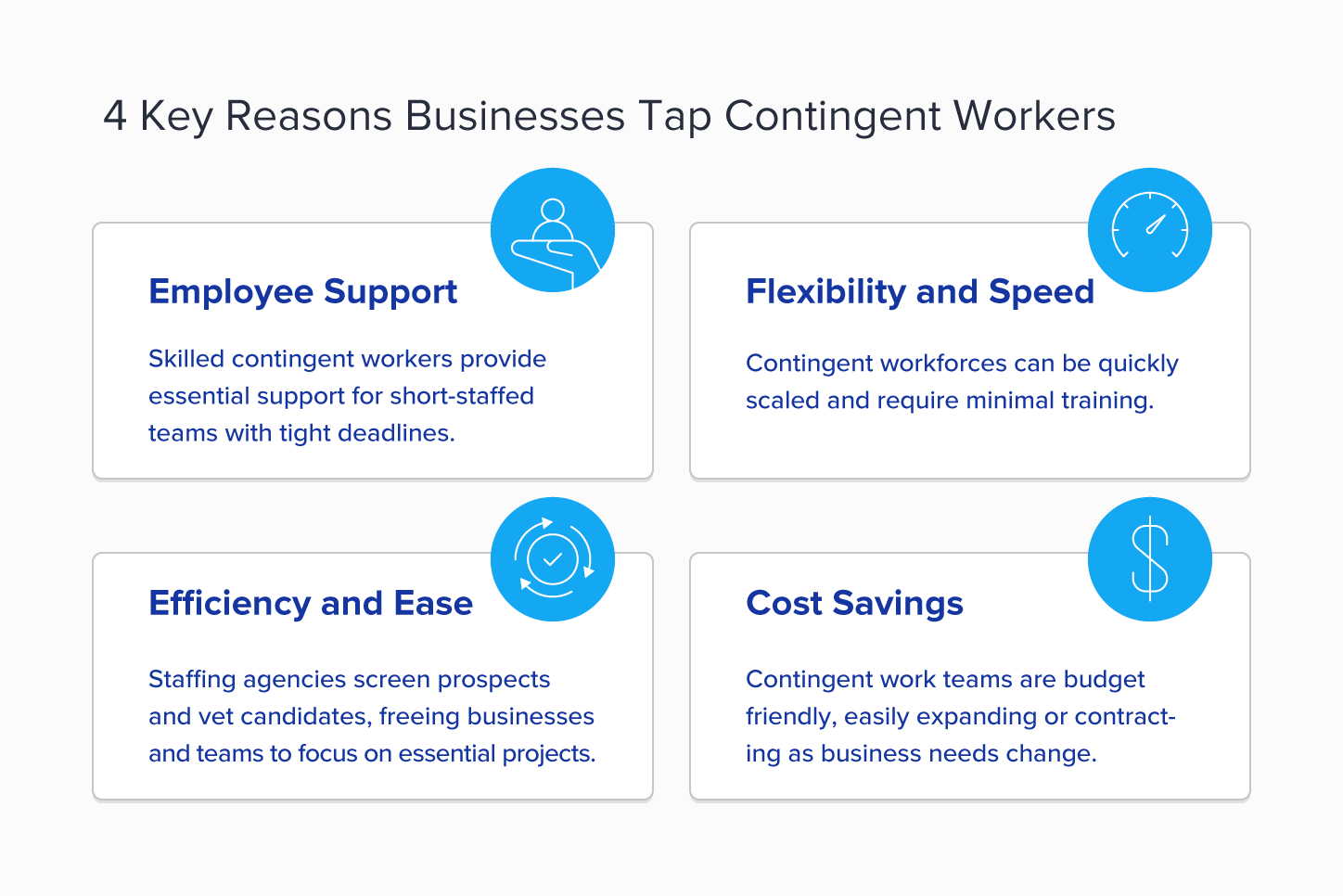6 Steps to Setting Up a Successful Contingent Workforce Program
authors are vetted experts in their fields and write on topics in which they are extremely knowledgeable. All of our content is peer reviewed and validated by world-class professionals.

A robust contingent workforce program can provide businesses with specific skills and expertise when they need them most—without the exorbitant cost and time commitment associated with full-time hiring. And, in the post-COVID-19 future of work, contingent and contract workers will play a bigger role than ever before as companies look to bridge skill gaps and navigate hybrid workplaces. According to a 2021 survey by Randstad Sourceright, a global talent acquisition consultancy based in Amsterdam, 56% of executives say they plan to shift more roles to freelance, project, or contract work.
Agility was named the key driver of talent strategy by 77% of the 850 C-level executives and talent leaders in the Randstad survey. And contingent workforces can scale up or down as needed, allowing companies to quickly staff in-demand roles for in-demand projects. Businesses’ growing reliance on contingent workers is a key trend that Intuit expects to define the future of work for the next decade.
But launching a successful contingent workforce program takes time and planning. These six steps will help business leaders anticipate every part of the process, from making a case for contingent workers to evaluating the program’s success and refining it along the way.
Make a Business Case for Why Your Company Needs Contingent Workers
Before you hire a single contingent worker or contract with a staffing firm, you must first “understand the why,” says Bretton Putter, Founder and CEO of CultureGene, a London-based workplace-culture consultancy for high-growth clients including Experian and Outbrain. For some businesses, the “why” for bringing on freelance or contract workers may be to save money or operate more efficiently. Other companies may need additional support or specialized skills to help an in-house team meet deadlines or complete a critical project.
A strong business case should help senior management see precisely how a contingent worker program will contribute to the company’s overall strategy and deliver results, says Jeff Turnage, Global Category Manager of Suez Waters USA Inc., an international firm that manages municipal and corporate water, soil, and waste. A robust proposal for a contingent workforce program should also address leaders’ potential concerns or objections, which might include the cost and the time that team members would have to devote to managing and training new workers. A successful case must make a clear argument that contingent workers will add value and increase efficiency, rather than adding complications, Putter says.
“You’ve really got to sell us in from a budgetary point of view, from a need point of view, but also from a value add and from a lack of interference point of view,” he says. “That’s how I would position it in an organization: We need it, and financially, it’s the right solution. [I’d also] probably focus on speed of execution.”

Gather Key Data to Dictate Contingent Workforce Strategies
Consultants recommend reviewing metrics such as your team size, the number of hours per week they are working, and how much overtime they’re logging. Is the demand consistent or seasonal, or is it triggered by a single project? Long-term temporary workers might be the right fit for a continuing effort, but on-demand workers would be a better match when work volume ebbs and flows.
Other considerations include how quickly your team or group needs to scale, how imminent deadlines are, and how many other deliverables already in the pipeline are demanding your workers’ attention.
Bringing on the right number of people, at the right time, and at the right rate is vital to launching a successful, cost-effective contingent workforce program, Turnage says. “Some people make the mistake of bringing resources on too early and having to pay for them even though they’re not 100% utilized.” He recalls times when he was a contract consultant, when clients brought him in too early or too often: “They would want me on a call and I may not say anything on that call, but I was sitting there for an hour and obviously billed for an hour. So, take that and multiply it times 10, 15, or 20 [contingent workers] across the company, and that’s a lot of money.”
To staff a project with the right talent for the right period of time, you’ll need to provide staffing vendors with key details, including start and end dates, and what deliverables and goals need to be met for the project to be considered a success, Putter says.
Contingent staffing suppliers also should have a solid understanding of your company’s standard operating procedures, including how metrics are driven, and how often key performance indicators (KPIs) are measured, Turnage says.
Appoint a Contingent Workforce Team Manager
The logistics of contingent talent management can be daunting. So, ensuring open and clear communication between suppliers and the hiring business is critical when considering how to create a contingent workforce.
An in-house point person should handle what Turnage calls “the noise”: managing the day-to-day operations, interacting with suppliers, overseeing onboarding and training, ensuring compliance, reviewing contracts, handling issues that arise with vendor management systems, liaising with HR and legal, and meeting with executives for monthly status updates.
At Farmers Insurance, many of the duties of a contingent workforce team manager are handled by Koenraad Lecot, who was tapped in 2013 to oversee and centralize the company’s use of contract workers. As Head of Contingent Workforce Management, Lecot coordinates 90 suppliers worldwide who provide Farmers with 5,300 contingent workers. Staffing agencies provide temporary workers for the office jobs, and Farmers contracts with specialized service providers for some IT functions, call center staffing, and janitorial and cafeteria operations.
One of Lecot’s first and most time-consuming tasks was to create a centralized system and repository to track contracts and ensure consistency in performing background checks and issuing credentials for contingent workers. Before he took the role, each department had its own suppliers, and the company lacked clear, congruent policies.
Lecot also says it’s important to support contingent workforce management system with a robust technology platform. Vendor management systems such as Beeline and SAP Fieldglass help companies manage all aspects of their contingent workforce, including finding and hiring workers, conducting background checks, and paying suppliers.
Set Goals and Ground Rules
A clearly defined process and KPIs are “massive, massive, massive,” Putter says. “If you don’t have a process in place, everybody’s going to be rowing in opposite directions, and you’re going to rely on individuals on both sides—the contingent workforce and individuals in the organization—to make [things] happen.” That’s a recipe for delays, duplicated work, and power struggles.
With their online class on contingent management, Staffing Industry Analysts taught Lecot how to set KPIs in four categories: costs, quality, efficiency, and risk. He highly recommends their approach. Lecot uses scorecards to rate Farmers’ suppliers on how effectively they meet those KPIs— information that he shares with company leaders. (Staffing Industry Analysts also accredits managers of contingent workforces as Certified Contingent Workforce Professionals, or CCWPs, a title Turnage holds.)
Every staffing supplier for Farmers must sign a standard services agreement that spells out the broad parameters of the business relationship, which can include requirements for background checks, professional liability and workers’ compensation insurance, nondisclosure or confidentiality policies, and limits on the staffing company using subcontractors. Details about specific tasks and project scopes are covered in an additional statement of work.
As part of crafting these agreements, Lecot collaborated with Farmers’ legal and HR teams to develop compliance policies for contingent workers. Farmers also instituted across-the-board background checks, which some previous contracts had lacked.
Educate In-house Teams on the Importance of Their New, Contingent Co-workers
At some companies, in-house employees and managers may misunderstand the contingent workforce market and underestimate these workers’ value to the business. Managers need to respect and appreciate the contingent team and their contributions to the company’s overarching mission, Lecot says. Contingent work often appeals to people who want the freedom to set their own schedules and cherry-pick the projects that spark their interest. Their departures can derail or delay a project critical to a business’s success.
“For certain areas, especially IT, it is very hard to find people, even contingent workers,” he says. “The market is so tough. So, we have to make sure that Farmers continues to be an attractive place for people to work.”
Collect Feedback to Refine Your Program
One effective strategy for determining whether a contingent worker program is living up to expectations is to gather feedback from contractors, staffers, and managers. Farmers does this with twice-a-year surveys of its contingent worker suppliers, who are asked to rate their experience with company hiring managers and the technology they use. Farmers then deploys that feedback to assemble a list of action items and program changes.
Turnage also recommends this type of feedback because it can help teams better collaborate with contingent workforce suppliers. Some helpful questions to answer, he says, might be: “Are [in-house teams] taking too long to respond to résumés, or are job specifications not very clear? Those types of things are very important for you to be able to modify the program or modify behaviors when needed.”
Every three months, Lecot meets with senior executives from finance, IT, HR, and other partners in an hourlong session to share industry updates, diversity and inclusion initiatives, and to review KPIs (e.g., contingent workforce cost savings, head count, compliance objectives, and onboarding times).
Businesses and teams can achieve their goals faster and more easily when they know they can rely on a talented, flexible contingent workforce. Putting the right processes in place to create, manage, and refine your contingent worker program will deliver the best possible outcomes for your bottom line and for your workers—whether they’re full time or freelance.
